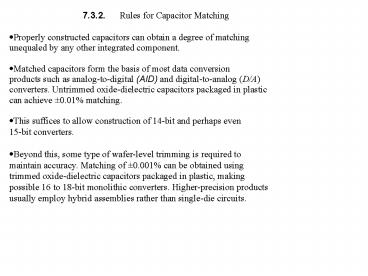7'3'2'Rules for Capacitor Matching - PowerPoint PPT Presentation
1 / 7
Title:
7'3'2'Rules for Capacitor Matching
Description:
times as large as metal-polycide capacitors. ... 2. Use square geometries for precisely matched ... The optimum dimensions of square capacitors in several CMOS ... – PowerPoint PPT presentation
Number of Views:60
Avg rating:3.0/5.0
Title: 7'3'2'Rules for Capacitor Matching
1
- 7.3.2. Rules for Capacitor Matching
- Properly constructed capacitors can obtain a
degree of matching unequaled by any other
integrated component. - Matched capacitors form the basis of most data
conversion products such as analog-to-digital
(AID) and digital-to-analog (D/A) converters.
Untrimmed oxide-dielectric capacitors packaged in
plastic can achieve 0.01 matching. - This suffices to allow construction of 14-bit and
perhaps even - 15-bit converters.
- Beyond this, some type of wafer-level trimming is
required to maintain accuracy. Matching of
0.001 can be obtained using trimmed
oxide-dielectric capacitors packaged in plastic,
making possible 16 to 18-bit monolithic
converters. Higher-precision products usually
employ hybrid assemblies rather than single-die
circuits.
2
- Silicided polysilicon (polycide) is sometimes
used for constructing the lower plates of
matched capacitors because its low resistance
minimizes depletion effects and because this
material can withstand the high temperatures
required to densify the deposited-oxide
dielectric. - Aluminum is the material of choice for the upper
plate due to the absence of depletion effects in
this material. - Capacitors constructed using unsilicided poly
electrodes experience significant surface
depletion, even when the poly is heavily doped.
These capacitors therefore exhibit temperature
coefficients several times as large as
metal-polycide capacitors. - Despite these problems, poly-poly capacitors can
still obtain adequate matching for all but the
most precise applications.
3
RULES FOR CAPACITOR MATCHING
1. Use identical geometries for matched
capacitors.
2. Use square geometries for precisely matched
capacitors.The smaller the periphery-to-area
ratio, the higher the obtainable degree of
matching. Rectangular capacitors with moderate
aspect ratios (21 or 31) can be used to
construct moderately matched capacitors.
3. Make matched capacitors as large as
practical.The optimum dimensions of square
capacitors in several CMOS processes are
reported to lie between 20 x 20mm and 50 X
50mm.Capacitors larger than about 1000mm2 should
be divided into multiple unit capacitors, as
proper cross-coupling will minimize gradient
effects and improve overall matching.
4
4. Place matched capacitors adjacent to one
another. For example, if thirty-two matched
capacitors are required, then consider using a 4
x 8 array. Alternatively, a 5 X 7 array could be
constructed and the three unused capacitors
connected as dummies.
5. Place matched capacitors over field
oxide. Matched capacitors should always reside
over field oxide well away from the edges of
moat regions and diffusions.
6. Connect the upper electrode of a matched
capacitor to the higher-impedance node.because
this generally exhibits less parasitic
capacitance than the lower electrode.
5
7. Place dummy capacitors around the outer edge
of the array. Dummy capacitors will shield the
matched capacitors from lateral electrostatic
fields and will eliminate variations in etch
rates. The dummy capacitors need not have the
same width width as the capacitors of the array
as long as an electrostatic shield covers the
array. Otherwise, fringing fields can easily
extend 30 to 50mm, and arrays of identical dummy
capacitors must extend at least this far to
ensure precise matching. Moderate matching
generally requires only a minimum-width ring of
dummy capacitors.
6
10. Consider the capacitance of leads connecting
to the capacitor. The leads that connect a
matched capacitor into the circuit will
contribute some capacitance of their own. This
capacitance becomes of concern when one tries to
construct moderately or precisely matched arrays
of capacitors.
The total lead area on each capacitor should be
computed, and additional leads should be
inserted until the ratio of the lead capacitance
equals the ratio of the intended capacitors.
11. Do not run leads over matched capacitors
unless they are electrostatically shielded.
7
13. If possible, place capacitors in areas of low
stress gradients.
14. Place matched capacitors well away from power
devices.The direct impact of temperature
on matched capacitors is much smaller than on
resistors. Matched capacitors should still reside
at least 200 to 300mm away from power devices
that dissipate 250mW or more.











![Energy is FREE - Like the AIR that you breathe [File 2 (or 1) of 5] PowerPoint PPT Presentation](https://s3.amazonaws.com/images.powershow.com/9270442.th0.jpg?_=20190520017)



















